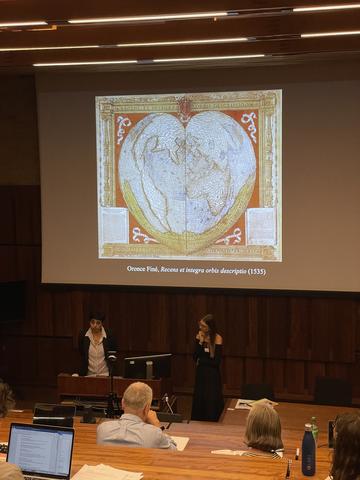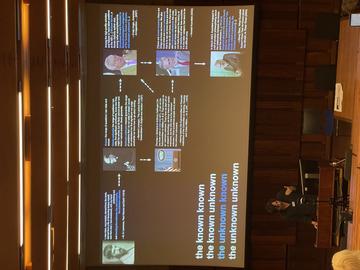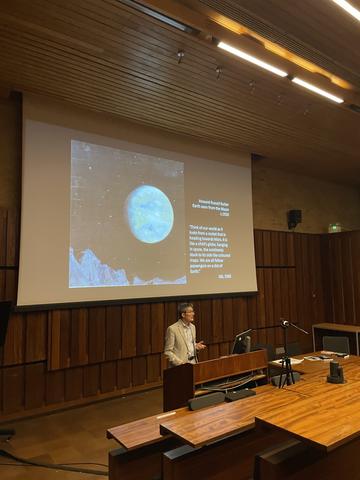On 24 December 1968, astronaut William Anders took one of the most iconic photographs of the twentieth century: Earthrise, showing our planet suspended in outer space. This now-familiar image—repeatedly hailed as a symbol of environmental awareness and planetary unity—was the starting point for a recent one-day conference at Oxford’s English Faculty, entitled Before Earthrise: Global Imagining in Literature and Visual Culture, 1550–1968. The conference took Earthrise not as an origin point, but as a threshold—turning back the clocks to excavate a long and varied history of ‘global imagining’ before the advent of the space age.
Organised by Dr Caroline Anjali Ritchie (Exeter College, Oxford) and generously supported by funding from the English Faculty and Exeter College, the event welcomed scholars from across the globe and a wide range of disciplines to consider earlier ways of visualising the planet. From globes and maps to poetry, fiction, and visual art, the papers demonstrated that the idea of ‘seeing the Earth’ has always been deeply imaginative—and even deeply political.
Keynote speaker Professor Ayesha Ramachandran (Yale University) opened the day with an immensely thought-provoking talk, which moved from medieval cosmologies to digital tools like Google Earth, asking how humans have tried to visualise the totality of their world—and what happens when they do. As Ramachandran has explored in her book The Worldmakers (Yale UP, 2015), the global is not just a question of scale but also one of metaphor, a way of thinking and imagining that links the everyday to the planetary.

Keynote lecture by Professor Ayesha Ramachandran. Photo by Alice Nightingale
The four panels that followed built on the ideas laid out in Ramachandran’s opening talk. Panel 1: ‘Travel, Transculturality, and Global Geography’ opened the day with papers by Caroline Kögler (Freie Universität Berlin), Chloe Fairbanks (University of Warwick), and Xinyao Zhang (University College London). Their presentations explored the spatial logics and geopolitical tensions inherent in early modern literary geographies—from Shakespeare’s global imagination, to the tension between colonial expansion and national insularity, and cultural encounters between Catholic and Confucian worldviews in early modern China.
Panel 2: ‘Visualising Early Modern Globes’ moved more explicitly into the material and iconographic history of terrestrial globes and maps. Hania Siebenpfeiffer (Philipps University Marburg), Martin Brückner (University of Delaware), and Vladimir Brljak (Durham University) examined a range of objects and texts, including engraved world-maps, the colour of outer space, and the global visions found in early modern fictions of space travel.

Dr Vladimir Brljak, ‘Around Earthrise – Dark Space as an Unknown Known of the Modern Cosmological Imagination.’ Photo by Alice Nightingale.
In the afternoon, Panel 3: ‘Ecological and Utopian Globes’ shifted focus toward the nineteenth century, bringing together talks by Kate Nankervis (University of York), Simon Ferdinand (University of Amsterdam), and Ya-Feng Wu (National Taiwan University). Topics ranged from tensions between the imperial and socialist politics of global images to Romantic visions of global-scale meteorology, culminating in a meditation on the ‘utopian globe’ as an ecological fantasy on the cusp of modernity.
The final session, Panel 4: ‘Earthrise on the Horizon,’ moved into the twentieth century and the modern pre-history of space-age global images. Anita Frison (University of Padua), Martina Morabito (University of Siena), Claire Reddleman (University of Manchester), and Robert Poole (University of Lancashire) each tackled forms of planetary representation in the modern age. Poole’s paper offered a fitting conclusion, by tracing the shifting meanings of ‘planet,’ ‘globe,’ and ‘Earth’ from 1870 to 1970, building on research presented in his influential book Earthrise: How Man First Saw the Earth (2008; recently revised in eBook, accompanied by colour illustrations).

Professor Robert Poole, ‘Planet, Globe, Earth – Changing Views of Earth 1870-1970.’ Photo by Alice Nightingale.
Throughout the day, one core idea remained constant: the notion that the image of the Earth—whether painted, mapped, written, or photographed—is never just a representation. It is an aspiration, a claim, a worldview. Together, the speakers at Before Earthrise revisited the globes of the past, reframing the modern image of the Earth not as a culmination, but as one moment in a long and potentially unending continuum of imaginative labour. In so doing, it opened new vistas for thinking about how the world has been—and continues to be—pictured, narrated, and known.
For more on the programme, including speaker bios and abstracts, visit the conference site: Before Earthrise.